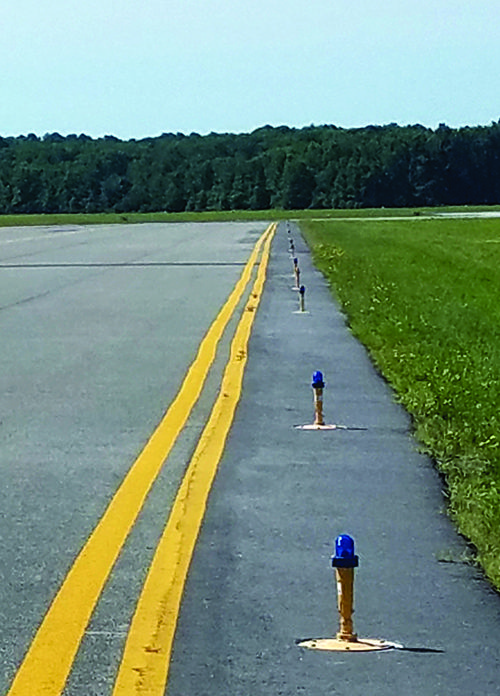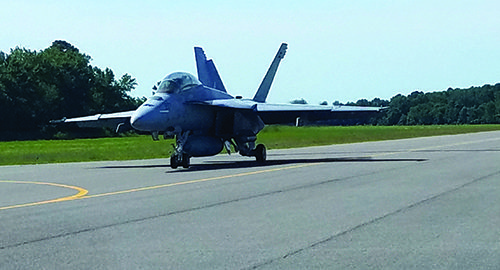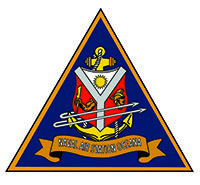Naval Air Station Oceana (NTU) in Virginia Beach, VA, is moving into the final stretch of a $120 million airfield project to reconstruct one runway and replace aging incandescent airfield lighting with energy-saving LED fixtures.
The $80 million electrical and lighting upgrade was a high priority because the previous system had been plagued with power failures, repeated maintenance issues and systematic shortcomings that sometimes disrupted operations. Improving the airfield lighting was imperative to support the associated Naval installation’s 16 squadrons, 300 based aircraft and 250,000 annual operations, explains Airport Manager James “Gramps” McDowell, C.M.
“Oceana had suffered a number of cascading failures from old cabling, direct burial and worn-out equipment,” says McDowell. “Equipment and circuit fires had forced the diversion of aircraft to other stations, which disrupted the squadron training and flight schedules. We knew it was only a matter of time before Oceana would be completely out of the night/instrument meteorological conditions flying business.”
|
Project: Airfield Upgrades Location: Naval Air Station Oceana—Virginia Beach, VA Major Components: Runway reconstruction; implementing LED lighting Total Cost: $120 million Electrical & Lighting Upgrades: $80 million (of total $120 million) General Contractor: The Lane Construction Corp. Electrical Contractor: Atlantic Electric Airfield Lighting Supplier: ADB Safegate Timeline: Construction began July 2015; completion anticipated in July 2019 Lighting Installed: 350 LED in-pavement runway guard lights; 300 LED airfield guidance signs; 800 Navy runway centerline lights; 500 high-intensity runway edge/threshold lights Of Note: Aircraft operations have not decreased with 2 of 4 runways closed for construction |
The project began more than a decade ago when officials began discussing how to improve lighting on NTU’s four runways (three 8,000 feet long, one 12,000 feet long). At the time, LED was just coming onto the market as the most energy-efficient fixture that would meet the airfield’s requirements.
“Our problem was that high-intensity LED lights were not yet approved by the FAA, just medium-intensity,” McDowell explains. “We continued down the road with the idea that we would at least get the taxiways done, make improvements to the runway edge lighting, and if LEDs were available for high-intensity at the time, then we would make LEDs the primary choice for the runways as well.”
Fortuitously, the U.S. Navy had rebuilt nearby Naval Auxiliary Landing Field Fentress in 2012 with all LED lighting and the same lighting control system planned for NTU. “Fentress became the test bed for what we wanted to do at Oceana, and Fentress has worked out extremely well,” remarks McDowell.
Beyond upgrading to LED technology, the lighting project at NTU also involved re-segmenting the airfield; increasing the number of circuits from 28 to 48; increasing, relocating and updating lighting vaults; and replacing airfield signage. “We shortened some of the runs, and with the five newly updated vaults, we would have less chance of a complete failure coming out of one vault. We interleaved the circuits, so if we lost something, we could at least survive for the moment and wouldn’t lose the entire taxiway or runway until we could come back to correct it.”
Electrical and lighting upgrades accounted for $80 million of the $120 million airfield project, which was funded through the U.S. Navy Special Projects budget. Construction began in July 2015, and the first LED fixtures were in place within three months. The project also involved the complete reconstruction of runway 14L-32R.
Above & Below Ground Work
In order to upgrade NTU’s airfield lighting, crews had to replace “every inch” of conduit and all underground cables, says Ryan Terry, district manager of The Lane Construction Corp., which served as general contractor for the project. “Upgrades included surveying the edge and centerline lights to adjust the locations to put the lights in a straight line, so they would be in line with the centerline of the runways and taxiways,” relates Terry. “This also meant the existing edge of pavements had to be adjusted, which involved removing and replacing paving and adjusting the new shoulder paving limits.”
One of the project’s biggest challenges was managing the airfield’s power consumption during the upgrade, notes Brian Nettles, senior project manager with Atlantic Electric. “Ultimately, we were renovating or constructing five vaults; but during the time of construction, there was one building from which 90% of the airfield was power sourced.”
“We had to maintain power and controls to the old lights that were still in service on runways and taxiways that were not completed while we installed new circuits, equipment and controls and brought the new airfield lighting control system (ALCS) on line in our work areas,” adds Terry. “This meant that before we went into a new phase of work and shut down power to a section of airfield, we had to first understand how to maintain power and controls to the rest of the airfield.”
Nettles explains that it was also difficult getting around the airfield to work on the vaults, lay power cables and ensure active areas were adequately lit during construction. “Our work often required us to cross active runways,” he recalls. “It was mind-boggling. There weren’t enough ways around active runways, so we had to cross them—and Oceana has four runways and four intersections. The volume of air traffic on this airfield compared to most other military airfields is huge.”
NTU is the only master jet base on the East Coast and home to the F/A-18 Hornet and Super Hornet. “It’s a very busy airfield, and supporting the Navy’s mission meant that we could not impact flight operations,” Terry says.
To ensure safety, a crew member maintained radio communication with the control tower at all times. “We needed people who were very competent to be on the radio,” Nettles stresses. “And it was still nerve-wracking at times to have to remember runway directions. For example, you had to remember if you were on 5R or 5L.”
Terry explains that Lane worked with the airport to create movement plans and identify areas that were available for work. “Active military operations meant that our plans could change at any time,” he recalls. “The schedule and crews had to be flexible to support the mission. Lane’s contracts included five phases of work and 91 sub-phases. Understanding each phase and how it impacted the movement of aircraft and the other phases was critical to our success.”
Twofold Cost Savings
McDowell looks forward to NTU consuming dramatically less power when the lighting project is completed next summer. “For us, it’s not only a cost savings, but also a savings in maintenance costs,” he comments. “We now know where all the circuits originate and where the vaults get power from. With all the updates to the switches and transformers, it’s all going to work much better.”
The specific LED fixtures used, L852N Navy Runway C/L from ADB Safegate, are stainless steel and designed to withstand tail hook damage from Navy tactical aircraft such as the F/A-18 Super Hornet. The upgrades place NTU at the forefront of airfield lighting technology, notes Galen Dixon, regional manager for ADB Safegate. All the electrical vault buildings have been built new or rebuilt, and the company’s Switchgear Regulator System powers the new lighting.
 According to Dixon, the low-wattage LED products are two to three times more efficient than traditional incandescent fixtures. Average life for the new fixtures should approach 100,000 hours.
According to Dixon, the low-wattage LED products are two to three times more efficient than traditional incandescent fixtures. Average life for the new fixtures should approach 100,000 hours.
“Not only will Oceana Naval Air Station see a reduction in energy usage, but also a substantial reduction in ongoing maintenance costs related to re-lamping incandescent fixtures. Typically, they would be re-lamping all fixtures one or two times per year. Now, they can go years without the need to re-lamp.”
Overall, the project required 350 LED in-pavement runway guard lights, 300 LED airfield guidance signs, 800 Navy runway centerline lights and 500 high-intensity runway edge/threshold lights.
“The benefit to pilots while landing and taxiing these massive machines is the additional safety LED provides because of its brightness and pure color wavelength that stays consistent at all steps of the constant current regulator,” says Dixon. “There will be no color shift, which is inherent to incandescent light sources that operate at varying brightness output. This provides a more consistent perception of the lights as pilots are landing and taxiing the airfield.”
 LED fixtures were not installed for approach lighting because high-intensity lights had not yet been approved for the application when the project started. When the airport opts to upgrade, it will only have to change the regulator size, notes Nettles.
LED fixtures were not installed for approach lighting because high-intensity lights had not yet been approved for the application when the project started. When the airport opts to upgrade, it will only have to change the regulator size, notes Nettles.
Steady Volume Despite Reduced Capacity
Terry says the biggest successes have been maintaining two control systems (the old and new) throughout the project and helping the Navy continue its regular traffic volume during construction. Effectively, the Navy has cut the operational capacity at NTU in half by removing two of four runways from service for construction, but it hasn’t reduced the number of operations performed, he explains. “We are able to support the Navy’s mission while we work through the phases—without pilots being impacted.”
McDowell acknowledges that the project has been challenging. “We could have done less construction at one time, but we would have ended up with the same closures and it would have taken twice as long,” he reasons. “We’d be at this for seven or eight years instead of four.”
 Even though preliminary plans detailed how much ground would be affected, he didn’t envision what the airfield would look like during the height of construction. “There was digging everywhere,” McDowell chuckles. “We tried to be as efficient as possible, but we took the approach that if we’re going to do the runway and lighting, we were going to do it in a series of planned phases. At the same time, you had to have a sense of humor. There were times when I looked at myself and asked, ‘What the heck are we doing?’”
Even though preliminary plans detailed how much ground would be affected, he didn’t envision what the airfield would look like during the height of construction. “There was digging everywhere,” McDowell chuckles. “We tried to be as efficient as possible, but we took the approach that if we’re going to do the runway and lighting, we were going to do it in a series of planned phases. At the same time, you had to have a sense of humor. There were times when I looked at myself and asked, ‘What the heck are we doing?’”
When facing the typical inconveniences associated with ongoing construction, he focuses on the ultimate outcome: a safer, more reliable airfield that features a newly reconstructed runway and completely updated lighting system with accurate as-built drawings and a modern control system.





 facts&figures
facts&figures

